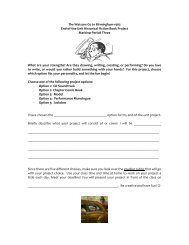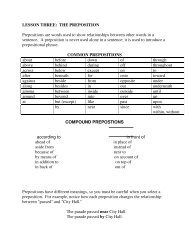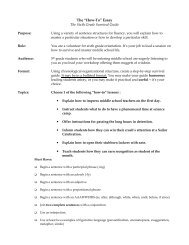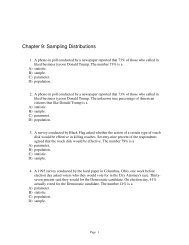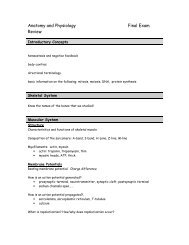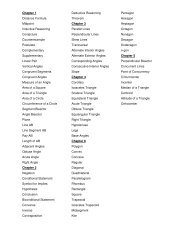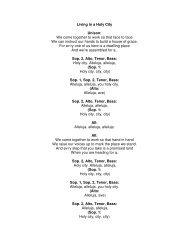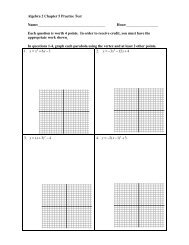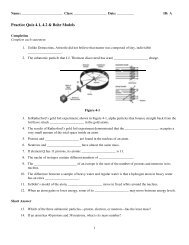10-7 Geometric Sequences 10-7 Geometric Sequences
10-7 Geometric Sequences 10-7 Geometric Sequences
10-7 Geometric Sequences 10-7 Geometric Sequences
Create successful ePaper yourself
Turn your PDF publications into a flip-book with our unique Google optimized e-Paper software.
<strong>10</strong>-7<br />
<strong>Geometric</strong> <strong>Sequences</strong><br />
This presentation was created following the Fair Use<br />
Guidelines for Educational Multimedia. Certain materials are<br />
included under the Fair Use exemption of the U. S. Copyright<br />
Law. Further use of these materials and this presentation is<br />
restricted.
Objectives<br />
• Students will recognize and extend<br />
geometric sequences.<br />
• Students will find geometric means.<br />
3/17/2008 2
Vocabulary<br />
• geometric sequence – a sequence in which<br />
each term after the nonzero first term is found by<br />
multiplying the previous term by a constant<br />
called the common ratio, where r ≠ 0, 1.<br />
• common ratio – the number each term is<br />
multiplied by to find the next term.<br />
• geometric means – the missing term between 2<br />
given terms in a geometric sequence. To find<br />
the missing term, multiply the two terms that the<br />
missing number is between and take the square<br />
root.<br />
3/17/2008 3
Formula for the nth Term of a<br />
<strong>Geometric</strong> Sequence<br />
a n = a 1 •r n-1<br />
a n = nth term<br />
a 1 = 1 st term<br />
r = common ratio<br />
n = term number<br />
3/17/2008 4
Determine whether the sequence is geometric.<br />
1, 4, 16, 64, 256, …<br />
Determine the pattern.<br />
1 4 16 64 256<br />
In this sequence, each term in found by multiplying the<br />
previous term by 4.<br />
Answer: This sequence is geometric.<br />
3/17/2008 5
Determine whether the sequence is geometric.<br />
1, 3, 5, 7, 9, 11, …<br />
Determine the pattern.<br />
1 3 5 7 9 11<br />
In this sequence, each term is found by adding 2 to the<br />
previous term.<br />
Answer: This sequence is arithmetic, not geometric.<br />
3/17/2008 6
Determine whether each sequence is geometric.<br />
a.<br />
Answer: yes<br />
b. 0, 11, 22, 33, 44, …<br />
Answer: no<br />
3/17/2008 7
Find the next three terms in the geometric sequence.<br />
20, –28, 39.2, …<br />
Divide the second term by the first.<br />
The common factor is –1.4. Use this information to find the<br />
next three terms.<br />
20, –28, 39.2<br />
–54.88 76.832 –<strong>10</strong>7.5648<br />
Answer: The next three terms are –54.88,<br />
76.832, and –<strong>10</strong>7.5648.<br />
3/17/2008 8
Find the next three terms in the geometric sequence.<br />
64, 48, 36, …<br />
Divide the second term by the first.<br />
The common factor is 0.8. Use this information to find the<br />
next three terms.<br />
64, 48, 36<br />
27 20.25 15.1875<br />
Answer: The next three terms are 27, 20.25,<br />
and 15.1875.<br />
3/17/2008 9
Find the next three terms in each geometric sequence.<br />
a. 42, 25.2, 15.12, …<br />
Answer: 9.072, 5.4432, 3.26592<br />
b. <strong>10</strong>0, –250, 625, …<br />
Answer: –1562.5, 3906.25, –9765.625<br />
3/17/2008 <strong>10</strong>
Geography The population of the African country of<br />
Liberia was about 2,900,000 in 1999. If the population<br />
grows at a rate of about 5% per year, what will the<br />
population be in the years 2003, 2004, and 2005?<br />
The population is a geometric sequence in which the first<br />
term is 2,900,000 and the common ratio is 1.05.<br />
3/17/2008 11
Year<br />
1999<br />
2000<br />
2001<br />
2002<br />
2003<br />
2004<br />
2005<br />
Population<br />
2,900,000<br />
2,900,000(1.05) or 3,045,000<br />
3,045,000(1.05) or 3,197,250<br />
3,197,250(1.05) or 3,357,112.5<br />
3,357,112.5(1.05) or 3,524,968.1<br />
3,524,968.1(1.05) or 3,701,216.5<br />
3,701,216.5(1.05) or 3,886,277.3<br />
Answer: The population of Liberia in the years 2003,<br />
2004, and 2005 will be about 3,524,968, 3,701,217,<br />
and 3,886,277, respectively.<br />
3/17/2008 12
Geography The population of the Baltic State of<br />
Latvia was about 2,500,000 in 1998. If the population<br />
grows at a rate of about 2% per year, what will the<br />
population be in the years 2003 and 2004?<br />
Answer: about 2,760,202 in 2003 and about 2,815,406<br />
in 2004<br />
3/17/2008 13
Find the eighth term of a geometric sequence in<br />
which<br />
Formula for the nth term of<br />
a geometric sequence<br />
3/17/2008 14
Answer: The eighth term in the sequence is 15,309.<br />
3/17/2008 15
Find the ninth term of a geometric sequence in<br />
which<br />
Answer: 786,432<br />
3/17/2008 16
Find the geometric mean in the sequence 7, ___, 112.<br />
In the sequence, and To find<br />
you must first find r.<br />
Formula for the nth term of<br />
a geometric sequence<br />
Divide each side by 7.<br />
3/17/2008 17
Simplify.<br />
Take the square root of each side.<br />
If the geometric mean is 7(4) or 28. If<br />
the geometric mean is 7(–4) or –28.<br />
Answer: The geometric mean is 28 or –28.<br />
3/17/2008 18
Find the geometric mean in the sequence 9, ___, 576.<br />
Answer: 72 or –72<br />
3/17/2008 19




